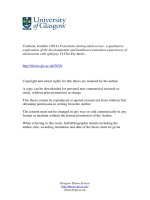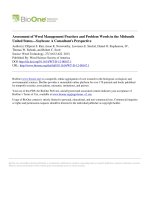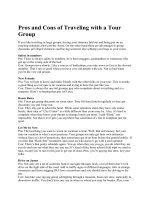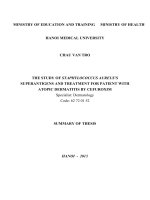Assessment of osteogenesis and cytotoxicity of implants with hESC progenies
Bạn đang xem bản rút gọn của tài liệu. Xem và tải ngay bản đầy đủ của tài liệu tại đây (3.74 MB, 106 trang )
ASSESSMENT OF OSTEOGENESIS AND
CYTOTOXICITY OF IMPLANTS WITH hESC
PROGENIES
WONG KEE HAU
NATIONAL UNIVERSITY OF SINGAPORE
2012
ASSESSMENT OF OSTEOGENESIS AND
CYTOTOXICITY OF IMPLANTS WITH hESC
PROGENIES
DR WONG KEE HAU
BDS (Singapore) FRACDS (Australia)
A THESIS SUBMITTED FOR THE DEGREE OF
MASTER OF SCIENCE (DENTISTRY)
DEPARTMENT OF ORAL & MAXILLOFACIAL SURGERY
FACULTY OF DENTISTRY
NATIONAL UNIVERSITY OF SINGAPORE
2012
DECLARATION
I hereby declare that this thesis is my original work and it has been
written by me in its entirety. I have duly adknowledged all the sources
of information which have been used in the thesis.
This thesis has also not been submitted for any degree in any university
previously.
_________________________________________
WONG KEE HAU
6 August 2012
Acknowledgement
I would like to express my sincere gratitude to the people and organisations that
have helped to make this research project a areality and success:
1. The Faculty of Dentistry for allowing me the opportunity to enrol in this
program.
2. A/Prof Yeo Jinn Fei, who guided and continuously encouraged my decision
to carry out a reaserch project for the MSc program. His support and
guidance encouraged me to be confident in me when there were doubts.
3. A/Prof Cao Tong, with his thoroughness and patience in guiding me
throughout the program. He allows me to think independently and is always
there to listen and give advice. He taught me how to ask scientific questions
and interpret data to answer those questions.
4. A/Prof Neoh Koon Gee and Dr Shi Zhi Long from the Department of
Chemical and Biomolecular Engineering for their support to the project and
help in preparaing the samples.
5. The team in stem cell laboratory, Mr Li Ming Ming whoʼs knowledge and
understanding of stem cells is so enormous and being so helpful. Ms Li Lu
Lu for her help with the draft and invaluable suggestions.
6. Last but not least, Mr Chan Swee Heng and Ms Angelin Han Tok Lin for their
help and support in allowing me to use the laboratory. Miss Zarina Zainol
and Miss Nurazreen Zaid
from the Dean's office for their administrative
i
support.
Grants and corporate sponsors:
Project supported by grant from Singapore Stem Cell Consortium (SSCC),
an initiative of the A*STAR Biomedical Research Council (BMRC)
Implant Direct Sybron Manufacturing LLC 27030 Malibu Hills Rd. Calabasas
Hills, CA
ii
Table of Contents
Acknowledgement ……………………………………………………………………… i
Table of Contents ………………………………………….……………………..…… iii
Summary ……………………………………………………………………………….. vi
List of Figures ………………………………………………………………..………… ix
Chapter I
Literature review ……………………………………………………..… 1
1.1
Dental Implant Surface and Osteogenesis
2
1.2
Testing of new implant surfaces: Animal and Clinical Studies
3
1.3
A new era of human embryonic stem cells (hESCs)
5
1.4
The advantages of human embryonic stem cells
5
1.5
Osteogenic differentiation of hESCs
5
Chapter II
Human Embryonic Stem Cells and their Uses ………………….. 8
2.1
Origin and characteristics of hESCs
9
2.2
Use of stem cells in dental implant material research
12
2.3
Processing and culture of hESCs
13
2.4
Differentiation of hESCS into osteoblasts
14
Chapter III
Methods of testing Dental Implant Materials …………………… 16
3.1
Past Present and Future
17
3.2
A new era of stem cell biology studies using hESC
19
3.3
Culture of hESCs
19
3.4
Test of different implant surfaces
21
Chapter IV Culture and Propagation of H9 hESCs ……..……………………. 23
iii
4.1
Culture and passage of H9 hESCs
24
4.2
Embryoid body (EB) formation
25
4.3
Pluripotency of H9 hESCs
28
4.4
Characterisation of undifferentiated H9 hESCs
30
Chapter V
Preparation of Implant samples and hFibroblasts ……………. 32
5.1
Implant material surface preparation
33
5.2
Sterilisation and microbial contamination test of implant samples
36
5.3
Fibroblast differentiation from hESC
38
Chapter VI Cytotoxicity test of implant materials …..………………………. 40
6.1
Cytotoxicity testing
41
6.2
Methods and Materials
42
6.3
Examination of Cell Attachment
43
6.4
MTS Assay Test
43
6.5
Results
44
6.6
Discussion
49
Chapter VII Osteogenesis test of implant samples …………………………. 50
7.1
Osteogenesis on implant surfaces
51
7.2
Methods and Materials
54
7.3
hESCs seeding
54
7.4
Test and Results
55
7.4.1 Confirmation tests
7.4.1.1 Alizarin Red assay
55
7.4.1.2 Total collagen assay
57
7.4.1.3 Immunostaining
58
iv
7.4.1.4 RT-PCR assay
7.4.2 Media Assay
65
7.4.2.1 Alkaline Phosphatase secretion assay
65
7.4.2.2 Osteocalcin secretion assay
67
7.4.3 Celllar and Proteomic Assay
7.5
63
68
7.4.3.1 Total cell number
68
7.4.3.2 Total protein concentration
69
7.4.3.3 Cellular ALP concentration
70
7.4.3.4 Cellular OC concentration
72
Discussion
73
Chapter VIII Conclusion
75
Chapter IX Prospectives
79
Chapter X
86
References
v
Summary
The search for the optimal dental implant surface for osseointegration
Research and development for an optimal interface between bone and dental or
medical implants has taken place for many years. The search for the ʻbestʼ surface
topography that improves the capacity for anchorage of bone has been on-going.
The predictability for an accepatable treatment outcome has been shown to be very
good for implants machined with a turning process, and also with surface
modifications through acid etching, blasted surface or coating with hydroxyapatite.
In order to determine if a new implant material or modification to the surface
conforms to the requirements of bio-functionality, biocompatibility and safety
specified by the International Organization for Standardization (ISO) and the
Organization for Economic Co-operation and Development (OECD) guidelines on
implant material and various surface treatments, it must undergo rigorous testing
both in vitro and in vivo.
The use of animals to test for products to be used in humans
Results from in vitro studies can be difficult to extrapolate to the in vivo situation.
For this reason the use of animal models is often an essential step in the testing of
implant materials prior to clinical use in humans. However, no species fulfils the
requirements of an ideal animal model1.
The Code of Ethics of the International Association for Dental Research (IADR)
(adopted May 2009) provides a set of guiding principles to promote exemplary
ethical standards in research and scholarship by investigators.
vi
The guidelines on animal research requires every effort must be made:
(a) to replace the use of live animals by non-animal alternatives;
(b) to reduce the number of animals used in research to the minimum required for
meaningful results; and
(c) to refine the procedures so that the degree of suffering is kept to a minimum.
It has been found that animals have not been treated humanely and do suffer
tremendous suffering physically and mentally in laboratories. The call for
alternatives to usng animals for research has been increasing over the years.
The poor state of animals in research laboratories has been reported previously2
and efforts are on-going to identify and remedy the conditions the animals are
being held3. The call for alternatives to using animals for research has gained pace
from 1980s based on the Three Rʼs of Russel and Burch (Reduction, Refinement,
Replacement). Government efforts on calls to alternatives has also increased4.
Worldwide it is estimated that the number of vertebrate animals used annually
ranges from the tens of millions to more than 100 million5. Government funded
animal testing costs U.S. taxpayers over $12 billion annually6. The fact that months
or years of human studies are also required suggests health authorities do not trust
the results. In 2004, the FDA reported that 92 out of every 100 drugs that
successfully had passed animal trials subsequently failed human trials7.
vii
The present study
Due to the limitations of animal studies for products to be used in humans, we
embark on a pilot study of using human embryonic stem cells (hESCs) progenies to
assess the cytotoxicity and osteogenesis of various dental implant surfaces.
hESC H9 line (Wicell Research Institute Inc. Agreement No. 04-W094, Madison,
Wisc. USA) derived fibroblasts and osteoblasts were examined on 4 different
implant surfaces. The surface modification types used in this study are:
1. Sand grit titanium (Ti)
2. Acid etch titanium (Etch)
3. Soluble Blast Material (SBM)
4. Hydroxyapatite (HA) coated
Cytotoxic response of the differentiated hESC fibroblastic progenies were tested by
FDA/PI staining and MTS assay.
Osteogenesis performance was measured by bone-alkaline phosphatase (ALP)
and osteocalcin (OC) secretion and mineral deposit by differentiated osteoblasts.
In summary, the objectives of this research is to study:
1.
Is there a possibility to extrapolate in-vitro studies of implant materials to
humans without going through animal studies?
2.
Can we identify and develop a better alternative to existing implant materials
or modification of the surface to improve bone adhesion growth on the implant
surface?
viii
List of Figures
Chapter IV
Figure 4.1
ES on MEF (40x magnification)
Figure 4.2
EB aggregates (40x magnification)
Figure 4.3
PCR results for Oct4 and Nanog for 2 different samples with β-actin
as control
Figure 4.4
SSEA 4 and DAPI stain of hESCs (40x magnification)
Figure 4.5
Merged oct4 and DAPI stain (40x magnification)
Chapter V
Figure 5.1
Implant surface (200x magnification)
Figure 5.2
SEM picture of the different surfaces of the implant samples
Figure 5.3
Placement of samples for testing
Figure 5.4
Contamination test for samples
Chapter VI
Figure 6.1
FDA stain (12.5x magnification)
Figure 6.2
FDA stain (40x magnification)
Figure 6.3
FDA stain (100x magnification)
Figure 6.4
FDA stain (200x magnification)
Figure 6.5
MTS assay for fibroblast attachment chart
Chapter VII
Figure 7.1
Alizarin stain at (12.5x magnification)
Figure 7.2
Alizarin stain at (100x magnification)
Figure 7.3
Total collagen assay chart
ix
Figure 7.4
Collagen RED ALP GREEN stain (12.5x magnification)
Figure 7.5
Collagen RED ALP GREEN stain (40x magnification)
Figure 7.6
Collagen RED ALP GREEN stain (100x magnification)
Figure 7.7
OC GREEN ALP RED stain (12.5x magnification)
Figure 7.8
OC GREEN ALP RED stain (40x magnification)
Figure 7.9
OC GREEN ALP RED stain (100x magnification)
Figure 7.10 RT-PCR assay chart
Figure 7.11 ALP secretion assay chart
Figure 7.12 OC secretion assay chart
Figure 7.13 Total protein concentration assay chart
Figure 7.14 Cellular ALP concentration assay
Figure 7.15 Cellular OC concentration assay
x
Chapter I
Literature Review
1
Literature Review
1.1 Dental Implant Surface and Osteogenesis
The implant surface has been recognized to be a critical factor for the achievement of
osseointegration8. Surface properties of the dental implant affect various
physiological and chemical processes such as protein adsorption, cell-surface
interaction and cell differentiation and growth at the interface between the bone and
the surface of the biomaterial9.
In the past 20 years, the structure and topography of dental implant surfaces has
been investigated extensively for applications in the dental implant industry10.
Different
surface
modification
techniques,
through
alteration
physicochemical, morphological, and/or biochemical properties
of
surface
have been
investigated in an effort to identify the surface that best supports attachment of cells
for osteogenic growth. The main goal of these studies was to determine whether
bone apposition could be enhanced by new micro-rough surfaces as compared to
the original implant surfaces. Various techniques have been used to produce
modifications to the implant surfaces, including sandblasting, acid-etching, a
combination of both, or hydroxyapatite coating in order to achieve better
osseointegration in a shorter time11. These new surface modifications had
demonstrated enhanced bone apposition in histomorphometric studies12,13.
2
This present research study will focus on current common titanium dental implant
surface modification types and the study of cytotoxicty and ossteogenesis on these
surfaces using hESC progenies.
Of particular future interest in the dental implant surface modification techniques are
biochemical methods of surface modification, which immobilize soluble or insoluble
molecules on the titanium surface for the purpose of inducing specific cells and
tissue responses.
1.2 Testing of new implant surfaces: Animal and Clinical Studies
In order to determine whether a new material conforms to the requirements of
biocompatibility and mechanical stability prior to clinical use, it must undergo
rigorous testing under both in vitro and then in vivo conditions.
In vitro testing for the characterisation of bone-contacting dental implant materials is
used primarily as a first stage test for acute toxicity and cytocompatibility to avoid
the unnecessary suffering of animals in the testing of cytologically inappropriate
materials. Results from in vitro studies can be difficult to extrapolate to the in vivo
situation, and for this reason, the use of animal models is often an essential step in
the testing of dental implants prior to clinical use in humans.
In the USA, the Food and Drug Administration (FDA) recommends animal and/or
3
clinical studies for dental implants with the following features:
a. designs dissimilar from designs previously cleared under 51O(k)
b. lengths less than 7 mm and/or implant diameters less than 3.25 mm
c. an angulation of the accompanying or recommended implant abutment greater
than 30 degrees.
Clinical investigation usually will include a randomized, well-controlled clinical trial
designed to demonstrate the substantial equivalence of the device when used as
described in the Indications for Use statement. For statistical purposes, the study
should demonstrate the device is substantially equivalent to, or not inferior to the
performance of devices with established designs. Each study arm should have a
statistically valid number of patients. Consultation with a statistician familiar with
medical device research statistics is highly recommended.
Clinical evaluation of implants and abutments should be conducted for a minimum of
three years with the implant under loaded conditions.
Data to be evaluated
should include such information as implant mobility, infections, broken fixtures or
abutments, adverse events and include a detailed explanation for all patients lost to
follow-up. Data derived from these investigations should meet the definition of valid
scientific data as defined in 21 CFR 860.7. The studies should be conducted by
qualified investigators experienced in implant dentistry, clinical research design, and
data analysis.
4
1.3 A new era of human embryonic stem cells (hESCs)
The first embryonic stem cells were isolated from mice in 1981 and a great deal of
research has been undertaken on mouse embryonic stem cells. A new era of stem
cell biology began in 1998, when the derivation of embryonic stem cells from human
blastocysts was first demonstrated14.
1.4 The advantages of human embryonic stem cells
In light of current knowledge, human embryonic stem cells (hESCs) have
advantages regarding potential use for basic research and stem cell based therapy.
1.
hESCs are genetically healthy and highly standardised
2.
hESCs are relatively homogenous and are pluripotent with the potential to
generate the various cell types in the body15
3.
hESCs are presently the only pluripotent stem cell that can be readily isolated
and grown in culture in unlimited numbers to be useful
1.5 Osteogenic differentiation of hESCs
Several reported studies achieved osteogenic differentiation of hESCs within 2D
culture plates in vitro, and scaffolds were utilized only as carriers for implantation
within live animals16,17,18. Three-dimensional structures have been thought to be
5
essential for bone formation within in vitro culture19.
To our knowledge, the first study comparing the osteogenic potential of hESC within
2D and 3D culture systems quantitatively was reported in 2007. The study
demonstrated that 3D culture system enhances osteogenic differentiation of hESCs
compared to conventional 2D culture in vitro20. An in vitro study demonstrated
proliferation and differentiation of osteoblasts within 3D printed PLGA scaffolds 21.
Several types of porous scaffolds have been shown to support in vitro bone
formation by human cells, including those made of ceramics22, native and synthetic
polymers23,24 and composite materials25.
In light of the difficulties of in vitro studies to extrapolate to the in vivo situation, the
use of animal models is required prior to clinical use in humans. The use of animal
models has inherent deficiencies and no species fulfils the requirements of an ideal
animal model. The development of stem cell research, primarily human embryonic
stem cells (hESCs) and their progenies, which has been shown to support in vitro
bone formation in different scaffold materials, has opened the possibility of
overcoming several essential steps in the testing of implant materials prior to clinical
use in humans.
To our knowledge, no research has been made using hESCs and their progenies to
study bone formation on implant materials presently used in the world.
6
In summary, the aim of this study is firstly, to examine the possibility of extrapolating
in-vitro studies of implant materials to humans using hESCs and their progenies
without further animal studies. We hope that with the success of this model, we will
be able to conduct research and development for an optimal interface between bone
and implant materials in a more economical, humane and importantly, using cell
lines of the actual host for testing of the products. Secondly, to study the possibility
of a new modified implant surface to identify and develop a better alternative to
existing implant materials or modification of the surface to improve bone adhesion
growth on the implant surface.
7
Chapter II
Human Embryonic Stem Cells (hESCs)
and their Uses
8
Chapter II Human Embryonic Stem Cells and their Uses
2.1
Origin and characteristics of human embryonic stem cells
Human embryonic stem cells (hESCs) can be derived from preimplantation embryo
at the blastocyst stage. At this stage, which is reached after about 5 days’ embryonic
development, the embryo appears as a hollow ball of 70-100 cells, called the
blastocyst. The blastocyst includes three structures: 1) the outer cell layer, which will
develop into the placenta; 2) the blastocoel, which is the fluid filled cavity inside the
blastocyst; and 3) the inner cell mass, from which the hESCs can be isolated.
The characteristics of human embryonic stem cells include:
- Potential to differentiate into the various cell types in the body (more than 200
types are known) even after prolonged culture. hESCs are referred to as pluripotent.
- Capacity to proliferate in their undifferentiated stage.
- Expansion of pluripotent markers Oct4, SSEA4
Growing human embryonic stem cells in the laboratory26
In order to derive the embryonic stem cells, the outer membrane of the blastocyst is
punctured, whereupon the inner cell mass with its stem cells is collected and
transferred into a laboratory culture dish that contains a nutrient broth known as
culture medium. The blastocyst is thereby destroyed and cannot develop further, but
the isolated hESCs can be cultivated in vitro and give rise to stem cell line. The stem
cell lines can be cryopreserved and stored in a cell bank. To be successful, the
9
cultivation requires, in addition to nutrient solution, so-called “feeder” cells or
support cells. Until recently fibroblasts from mice have been used for this purpose,
however scientists are exploring ways to propagate human ES cell lines using
human feeder layer or even culturing human ES cells without feeder layer. This
eliminates the risk that viruses or infectious agents in the mouse cells might be
transmitted to the human cells. If the stem cells are of good quality and if they show
no sign of ageing, the same stem-cell line can yield unlimited amounts of stem cells.
Besides their broad potential for differentiation, embryonic stem cell lines have
proved to be better able to survive in the laboratory than other types of stem cells. At
the various points during the process of generating embryonic stem cell lines,
various tests are carried out to examine the cells if they exhibit the fundamental
properties of embryonic stem cells.
The current advantages and limitations of human embryonic stem cells
Human embryonic and somatic stem cells each have advantages and limitations
regarding potential use for basic research and stem cell based therapy.
Advantages:
human ES cells are relatively homogenous and they are pluripotent15,27
human ES cells can be readily isolated and grown in culture in sufficient
numbers to be useful in clinical research
The isolation of human embryonic stem cells about a decade ago marked the birth
of a new era in biomedical research. These pluripotent stem cells possess unique
10
properties that make them exceptionally useful in a range of applications28.
Discussions about human stem cells are most often focused around the area of
regenerative medicine and indeed, the possibility to apply these cells in cell
replacement therapies is highly attractive.
More imminent, however, is the employment of stem cell technologies for drug
discovery, material testing and development. Novel improved in vitro models based
on physiologically relevant human cells will result in better precision and more
cost-effective assays ultimately leading to lower attrition rates and safer new drugs
and materials that are to be used in humans.
Limitations:
A significant potential limitation on the therapeutic use of human ES cells is the
problem of immune rejection. Because human ES cells will not normally have
been derived from the patient to be treated, they run the risk of rejection by the
patient’s immune system.
It has been argued that, because hESCs have the potential to differentiate into
all cell types, it might be difficult to ensure that, when used therapeutically, they
do not differentiate into inappropriate cell types or generate tumors. It is clearly
essential to guard against these risks particularly tumorgenesis.
11
Current methods for growing hESC lines in culture are adequate for research
purposes, but the co-culture of hESCs with animal materials necessary for
growth and differentiation would preclude their use in therapy.
Scientists are now working on generating stem cell lines, which are grown on
human feeder layer or without feeder layer and in completely defined culture
media29.
2.2 Use of hESCs in dental implant materials research
There are presently no known research on testing of the cytotoxicity and
osteogenesis of dental implant materials using hESCs and their progenies.
Stem cell research has become one of the biggest issues dividing the scientific and
religious communities around the world. To get stem cells that are reliable, scientists
either have to use an embryo that has already been conceived or else clone an
embryo using a cell from a patient's body and a donated egg. Either way, to harvest
an embryo's stem cells, scientists must destroy it. Although that embryo may only
contain four or five cells, some religious leaders say that destroying it is the
equivalent of taking a human life. Inevitably, this issue entered the political arena.
Stem cell research and the careers of stem cell researchers hang on a legal roller
coaster. Although stem cells have great potential for treating diseases, much work on
the science, ethical and legal fronts remains.
12









